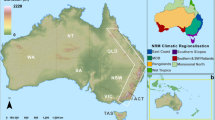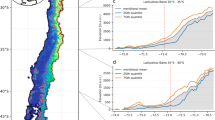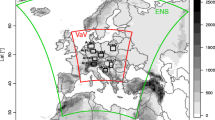Abstract
Precipitation and temperature biases from a set of Regional Climate Models from the CORDEX initiative have been analysed to assess the extent to which the biases may impact the climate change signal. The analysis has been performed for the South American CORDEX domain. A large warm bias was found over central Argentina (CARG) for most models, mainly in the summer season. Results indicate that the possible origin of this bias is an overestimation of the incoming shortwave radiation, in agreement with an underestimation of the relative humidity at 850 hPa, a variable that could be used to diagnose cloudiness. Regarding precipitation, the largest biases were found during summertime over northeast of Brazil (NEB), where most models overestimate the precipitation, leading to wet biases over that region. This bias agrees with models’ underestimation of both the moisture flux convergence and the relative humidity at lower levels of the atmosphere. This outcome suggests that the generation of more clouds in the models may drive the wet bias over NEB. These systematic errors could affect the climate change signal, considering that these biases may not be stationary. For both CARG and NEB regions, models with higher warm biases project higher warming levels, mainly in the summer season. In addition, it was found that these relationships are statistically significant with a confidence level of 95%, pointing out that biases are linearly linked with the climate change signal. For precipitation, the relationship between the biases and the projected precipitation changes is only statistically significant for the NEB region, where models with the largest wet biases present the greatest positive precipitation changes during the warm season. As in the case of biases, the analysis of the temperature and precipitation projections over some regions of South America suggests that clouds could affect them. The results found in this study point out that the analysis of the bias behaviour could help in a better interpretation of the climate change signal.











Similar content being viewed by others
Data availability
The CORDEX regional climate models are available at: https://cordex.org/data-access/.
The CPC dataset is available at: https://psl.noaa.gov/data/gridded/data.cpc.globaltemp.html and https://psl.noaa.gov/data/gridded/data.cpc.globalprecip.html.
The ERA-interim reanalysis are available at: https://www.ecmwf.int/en/forecasts/datasets/reanalysis-datasets/era-interim.
The GLDAS data is available at: https://ldas.gsfc.nasa.gov/data.
The GEWEX-SRB dataset is available at: https://asdc.larc.nasa.gov/project/SRB.
References
Allen M, Frame D, Kettleborough J, Stainforth D (2006) Modelerror in weather and climate forecasting. In: Palmer T, Hagedorn R (eds) Predictability of weather and climate. Cambridge University Press, Cambridge, pp 391–427
Bambach NE, Rhoades AM, Hatchett BJ, Jones AD, Ullrich PA, Zarzycki CM (2022) Projecting climate change in South America using variable-resolution community earth system model: an application to chile. Int J Climatol 42:2514–2542. https://doi.org/10.1002/joc.7379
Blázquez J, Nuñez MN (2013) Performance of a high resolution global model over southern South America. Int J Climatol 33:904–919. https://doi.org/10.1002/joc.3478
Blázquez J, Solman SA (2020) Multiscale precipitation variability and extremes over South America: analysis of future changes from a set of CORDEX regional climate model simulations. Clim Dyn 55:2089–2106. https://doi.org/10.1007/s00382-020-05370-8
Boberg F, Christensen JH (2012) Overestimation of Mediterranean summer summer temperature projections due to model deficiencies. Nat Clim Change 2:433–436. https://doi.org/10.1038/nclimate1454
Bordoy R, Burlando P (2013) Bias correction of regional climate model simulations in a region of complex orography. J Appl Meteorol Climatol 52(1):82–101. https://doi.org/10.1175/JAMC-D-11-0149.1
Cavalcanti IFA, Silveira VP (2016) Changes in precipitation over the La Plata Basin, projected by CLARIS-LPB regional models. Clim Res 68:169–182. https://doi.org/10.3354/cr01392
Cheruy F, Campoy A, Dupont JC, Ducharne A, Hourdin F, Haeffelin M, Chiriaco M, Idelkadi A (2013) Combined influence of atmospheric physics and soil hydrology on the simulated meteorology at the SIRTA atmospheric observatory. Clim Dyn 40:2251–2269. https://doi.org/10.1007/s00382-012-1469-y
Chou S, Lyra A, Mourão C, Dereczynski C, Pilotto I, Gomes J, Bustamante J, Tavares P, Silva A, Rodrigues D, Campos D, Chagas D, Sueiro G, Siqueira G, Nobre P, Marengo J (2014) Evaluation of the eta simulations nested in three global climate models. Am J Clim Change 3:438–454. https://doi.org/10.4236/ajcc.2014.35039
Christensen JH, Boberg F (2012) Temperature dependent climate projection deficiencies in CMIP5 models. Geophys Res Lett 39:L24705. https://doi.org/10.1029/2012GL053650
Christensen JH, Boberg F, Christensen OB, Lucas-Picher P (2008) On the need for bias correction of regional climate change projections of temperature and precipitation. Geophys Res Lett 35:L20709. https://doi.org/10.1029/2008GL035694
Dee DP et al (2011) The ERA-interim reanalysis: configuration and performance of the data assimilation system. Q JR Meteorol Soc 137:553–597. https://doi.org/10.1002/qj.828
Dodson R, Marks D (1997) Daily air temperature interpolated at high spatial resolution over a large mountainous region. Clim Res 8:1–20
Falco M, Carril AF, Menéndez CG, Zaninelli PG, Li LZ (2019) Assessment of CORDEX simulations over South America: added value on seasonal climatology and resolution considerations. Clim Dyn 52:4771–4786. https://doi.org/10.1007/s00382-018-4412-z
Gao L, Deng H, Lei L, Wei J, Chen Y, Li Z, Ma M, Chen X, Chen Y, Liu M, Gao J (2021) Evidence of elevation-dependent warming from the chinese Tian Shan. The Cryosphere 15:5765–5783. https://doi.org/10.5194/tc-15-5765-2021
Giorgi F, Gutowski W (2015) Regional dynamical downscaling and the cordex initiative. Annu Rev Environ Resour 40:467–490. https://doi.org/10.1146/annurev-environ-102014-021217
Giorgio N (2017) Relation between cloud cover and relative humidity. Bachelor Thesis. University of Utrecht. Available: https://studenttheses.uu.nl/bitstream/handle/20.500.12932/25986/Paper%20Relative%20Humidity.pdf?sequence=2
Gnitou GT, Tan G, Niu R, Nooni IK (2021) Assessing Past Climate Biases and the added value of CORDEX-CORE Precipitation Simulations over Africa. Remote Sens 13(11):2058. https://doi.org/10.3390/rs13112058
Gutiérrez JM, Jones RG, Narisma GT, Alves LM, Amjad M, Gorodetskaya IV, Grose M, Klutse NAB, Krakovska S, Li J, Martínez-Castro D, Mearns LO, Mernild SH, Ngo-Duc T, van den Hurk B, Yoon J-H (2021) Atlas. In: Zhai VP, Pirani A, Connors SL, Péan C, Berger S, Caud N, Chen Y, Goldfarb L, Gomis MI, Huang M, Leitzell K, Lonnoy E, Matthews JBR, Maycock TK, Waterfield T, Yelekçi O, Yu R, Zhou B (eds) Climate Change 2021: the physical science basis. Contribution of Working Group I to the Sixth Assessment Report of the Intergovernmental Panel on Climate Change [Masson-Delmotte. Cambridge University Press, Cambridge, pp 1927–2058. https://doi.org/10.1017/9781009157896.021
Gutowski WJ, Giorgi F, Timbal B, Frigon A, Jacob D, Kang H-S, Raghavan K, Lee B, Lennard C, Nikulin G, O’Rourke E, Rixen M, Solman S, Stephenson T, Tangang F (2016) WCRP coordinated regional downscaling experiment (CORDEX): a diagnostic MIP for CMIP6. Geosci Model Dev 9:4087–4095. https://doi.org/10.5194/gmd-9-4087-2016
Hawkins E, Sutton R (2011) The potential to narrow uncertainty in projections of regional precipitation change. Clim Dyn 37:407–418. https://doi.org/10.1007/s00382-010-0810-6
Ivanov MA, Luterbacher J, Kotlarski S (2018) Climate model biases and modification of the climate change signal by intensity-dependent bias correction. J Clim 31:6591–6610. https://doi.org/10.1175/JCLI-D-17-0765.1
Jakob C, Miller M (2003) Parameterization of physical processes. Clouds. In: Holton JR (ed) Encyclopedia of atmospheric sciences. Academic Press, New York, pp 1692–1698
Künsch C, Schär HR (2003) Assesment of bias assumptions for climate models. J Clim 27:6799–6818. https://doi.org/10.1175/JCLI-D-17-0765.1
Lin Y, Dong W, Zhang M, Xie Y, Xue W, Huang J, Luo Y (2017) Causes of model dry and warm bias over central U.S. and impact on climate projections. Nat Commun 8:881. https://doi.org/10.1038/s41467-017-01040-2
Leyba IM (2020) Estudio de la interacción océano-atmósfera en el Atlántico Sur y su rol en la precipitación en el sur de Sudamérica. Ph.D Thesis. University of Buenos Aires. Available at: https://bibliotecadigital.exactas.uba.ar/download/tesis/tesis_n6769_Leyba.pdf
Llopart M, Reboita MS, da Rocha RP (2020) Assessment of multimodel climate projections of water resources over South America CORDEX domain. Clim Dyn 54:99–116. https://doi.org/10.1007/s00382-019-04990-z
Llopart M, da Rocha RP, Reboita M, Cuadra S (2017) Sensitivity of simulated South America climate to the land surface schemes in RegCM4. Clim Dyn 49:3975–3987. https://doi.org/10.1007/s00382-017-3557-5
López-Franca N, Zaninelli PG, Carril AF, Menéndez CG, Sánchez E (2016) Changes in temperature extremes for 21st century scenarios over South America derived from a multi-model ensemble of regional climate models. Clim Res 68:151–167. https://doi.org/10.3354/cr01393
Maraun D (2012) Nonstationarities of regional climate model biases in european seasonal mean temperature and precipitation sums. Geophys Res Lett 39:L06706. https://doi.org/10.1029/2012GL051210
Ménard R (2010) Bias estimation. In: Lahoz W, Khattatov B, Menard R (eds) Data Assimilation. Springer, Berlin, pp 113–135. https://doi.org/10.1007/978-3-540-74703-1_6
Peng X, Wu W, Zheng Y, Sun J, Hu T, Wang P (2020) Correlation analysis of land surface temperature and topographic elements in Hangzhou, China. Sci Rep 10:10451. https://doi.org/10.1038/s41598-020-67423-6
Pepin N, Bradley RS, Diaz HF, Baraer M, Caceres EB, Forsythe N, Fowler H, Greenwood G, Hashmi MZ, Liu XD, Miller JR, Ning L, Ohmura A, Palazzi E, Rangwala I, Schöner W, Severskiy I, Shahgedanova M, Wang MB, Williamson SN, Yang DQ (2015) Elevation-dependent warming in mountain regions of the world. Nat Clim Change 5:424–430. https://doi.org/10.1038/nclimate2563
Quaas J (2012) Evaluating the “critical relative humidity” as a measure of subgrid-scale variability of humidity in general circulation model cloud cover parameterizations using satellite data. J Geophys Res 117:D09208. https://doi.org/10.1029/2012JD017495
Reboita MS, da Rocha RP, Dias CG, Ynoue RY (2014) Climate projections for South America: RegCM3 driven by HadCM3 and ECHAM5. Adv Meteorol. https://doi.org/10.1155/2014/376738
Sánchez E, Solman S, Remedio ARC, Berbery H, Samuelsson P, da Rocha RP, Mourão C, Li L, Marengo J, de Castro M, Jacob D (2015) Regional climate modelling in CLARIS-LPB: a concerted approach towards twenty first century projections of regional temperature and precipitation over South America. Clim Dyn 45:2193–2212. https://doi.org/10.1007/s00382-014-2466-0
Shakespeare CJ, Roderick ML (2021) The clear-sky downwelling long-wave radiation at the surface in current and future climates. Q J R Meteorol Soc 147:4251–4268. https://doi.org/10.1002/qj.4176
Simmons A, Uppala S, Dee D, Kobayashi S (2007) ERA-interim: new ECMWF reanalysis products from 1989 onwards. ECMWF Newsl 110:25–35
Solman SA (2016) Systematic temperature and precipitation biases in the CLARIS-LPB ensemble simulations over South America and possible implications for climate projections. Clim Res 68:117–136. https://doi.org/10.3354/cr01362
Solman SA, Sanchez E, Samuelsson P, da Rocha R (2013) Evaluation of an ensemble of regional climate model simulations over South America driven by the ERA-Interim reanalysis: models’ performance and uncertainties. Clim Dyn 41:1139–1157. https://doi.org/10.1007/s00382-013-1667-2
Tamoffo AT, Amekudzi LK, Weber T, Vondou DA, Yamba EI, Jacob D (2022) Mechanisms of rainfall biases in two CORDEX-CORE regional climate models at rainfall peaks over central equatorial Africa. J Clim 35:639–668. https://doi.org/10.1175/JCLI-D-21-0487.1
Teutschbein C, Seibert J (2013) Is bias correction of regional climate model (RCM) simulations possible for non-stationary conditions? Hydrol Earth Syst Sci 17:5061–5077. https://doi.org/10.5194/hess-17-5061-2013
Torres RR, Marengo JA (2013) Uncertainty assessments of climate change projections over South America. Theor Appl Climatol 112:253–272. https://doi.org/10.1007/s00704-012-0718-7
Velázquez JA, Troin M, Caya D, Brissette F (2015) Evaluating the time-invariance hypothesis of Climate Model Bias correction: implications for hydrological impact studies. J Hydrometeorol 16:2013–2026. https://doi.org/10.1175/JHM-D-14-0159.1
Walcek CJ (1994) Cloud cover and its relationship to relative humidity during a springtime midlatitude cyclone. Monthly Weather Rev 122(6):1021–1035
Wang Q, Fan X, Wang M (2014) Recent warming amplification over high elevation regions across the globe. Clim Dyn 43:87–101. https://doi.org/10.1007/s00382-013-1889-3
Xie P, Yatagai A, Chen M, Hayasaka T, Fukushima Y, Liu C, Yang S (2007) A gauge-based analysis of daily precipitation over East Asia. J Hydrometeorol 8:607–626. https://doi.org/10.1175/JHM583.1
Zhang C, Xie S, Klein SA, Ma H-y, Tang S, Van Weverberg K, Morcrette CJ, Petch J (2018) CAUSES: diagnosis of the summertime warm bias in CMIP5 climatemodels at the ARM Southern Great Plains site. J Geophys Res Atmos 123:2968–2992. https://doi.org/10.1002/2017JD027200
Acknowledgements
The authors are grateful to two anonymous reviewers, whose comments and suggestions allowed improving the manuscript.
Funding
This work was supported by University of Buenos Aires Grant (UBACYT2018 20020170100117BA), Agencia Nacional de Promoción Científica y Tecnológica Grant (PICT-2018-02496), Universidad Nacional de La Plata Grants (PPID/G006 and PPID/G008).
Author information
Authors and Affiliations
Contributions
JB wrote the main manuscript text and prepared the figures. SSA reviewed and edited the manuscript text.
Corresponding author
Ethics declarations
Competing interests
The authors declare no competing interests.
Ethical approval
Not applicable.
Additional information
Publisher’s Note
Springer Nature remains neutral with regard to jurisdictional claims in published maps and institutional affiliations.
Electronic supplementary material
Below is the link to the electronic supplementary material.
Rights and permissions
Springer Nature or its licensor (e.g. a society or other partner) holds exclusive rights to this article under a publishing agreement with the author(s) or other rightsholder(s); author self-archiving of the accepted manuscript version of this article is solely governed by the terms of such publishing agreement and applicable law.
About this article
Cite this article
Blázquez, J., Solman, S.A. Temperature and precipitation biases in CORDEX RCM simulations over South America: possible origin and impacts on the regional climate change signal. Clim Dyn 61, 2907–2920 (2023). https://doi.org/10.1007/s00382-023-06727-5
Received:
Accepted:
Published:
Issue Date:
DOI: https://doi.org/10.1007/s00382-023-06727-5




